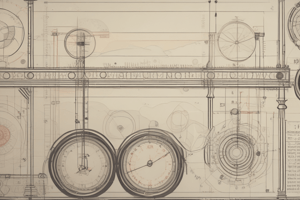Podcast
Questions and Answers
What is a major limitation of measurement methods?
What is a major limitation of measurement methods?
- They are limited to linear measurements
- They are only suitable for measuring small components
- They are time-consuming and prone to wear (correct)
- They require a high level of operator skill
What is the primary cause of natural variability in manufacturing processes?
What is the primary cause of natural variability in manufacturing processes?
- Random and uncontrollable causes (correct)
- Operator error and machine wear
- Defective raw materials and poor management
- Improperly adjusted machines and characteristic variability
What is the term for variability caused by assignable causes?
What is the term for variability caused by assignable causes?
- Characteristic variability (correct)
- Process variability
- Natural variability
- Assignable causes
What is the purpose of specifying tolerance limits in manufacturing?
What is the purpose of specifying tolerance limits in manufacturing?
What is the difference between the upper and lower limits of a tolerance?
What is the difference between the upper and lower limits of a tolerance?
What is the basic or nominal size of a component?
What is the basic or nominal size of a component?
What is the primary reason for providing clearance between a shaft and a hole?
What is the primary reason for providing clearance between a shaft and a hole?
What is the consequence of manufacturing a shaft and hole with zero clearance?
What is the consequence of manufacturing a shaft and hole with zero clearance?
What is the ideal condition for achieving a proper fit between a shaft and a hole?
What is the ideal condition for achieving a proper fit between a shaft and a hole?
What is the probability that a part will fall within 3σ limits of the mean value?
What is the probability that a part will fall within 3σ limits of the mean value?
What is the primary advantage of interchangeable manufacture?
What is the primary advantage of interchangeable manufacture?
What is the essential condition for interchangeable assembly?
What is the essential condition for interchangeable assembly?
What is the main advantage of using end standards over line standards?
What is the main advantage of using end standards over line standards?
What is the main limitation of line standards that affects their accuracy?
What is the main limitation of line standards that affects their accuracy?
What is the purpose of the built-in datum in end standards?
What is the purpose of the built-in datum in end standards?
What is the effect of temperature changes on line and end standards?
What is the effect of temperature changes on line and end standards?
What is the main difference between the principle of measurement of line and end standards?
What is the main difference between the principle of measurement of line and end standards?
What is the advantage of using groups of blocks or slip gauges in end standards?
What is the advantage of using groups of blocks or slip gauges in end standards?
What is the primary standard for length that is not affected by environmental conditions?
What is the primary standard for length that is not affected by environmental conditions?
Which of the following is a characteristic of the material standards used earlier?
Which of the following is a characteristic of the material standards used earlier?
What is the definition of a yard or metre in terms of a bar of metal?
What is the definition of a yard or metre in terms of a bar of metal?
What is the example of line standard?
What is the example of line standard?
What is end standard or end measurement?
What is end standard or end measurement?
What is the advantage of using the metric system?
What is the advantage of using the metric system?
What is the primary factor that determines the specification of tolerance limits if high performance is the sole criterion?
What is the primary factor that determines the specification of tolerance limits if high performance is the sole criterion?
What is the purpose of fit classification in manufacturing?
What is the purpose of fit classification in manufacturing?
What is the difference between the Hole Basis System and the Shaft Basis System in the ISO system of limits and fits?
What is the difference between the Hole Basis System and the Shaft Basis System in the ISO system of limits and fits?
What is the primary purpose of limit gauges in manufacturing?
What is the primary purpose of limit gauges in manufacturing?
What is the purpose of a No-Go Gauge in manufacturing?
What is the purpose of a No-Go Gauge in manufacturing?
What is the term for the maximum allowable dimension of a part?
What is the term for the maximum allowable dimension of a part?
What is the purpose of a plug gauge in manufacturing?
What is the purpose of a plug gauge in manufacturing?
What is the application of a transition fit?
What is the application of a transition fit?
What is the term for the permissible variation in a dimension?
What is the term for the permissible variation in a dimension?
What is the purpose of gauges in manufacturing?
What is the purpose of gauges in manufacturing?
What is the primary advantage of interchangeable assembly in manufacturing?
What is the primary advantage of interchangeable assembly in manufacturing?
What is the benefit of achieving specialization in labor?
What is the benefit of achieving specialization in labor?
What is universal interchangeability?
What is universal interchangeability?
What is the purpose of providing tolerances in manufacturing?
What is the purpose of providing tolerances in manufacturing?
What is the definition of tolerance?
What is the definition of tolerance?
What factor influences the choice of tolerances in manufacturing?
What factor influences the choice of tolerances in manufacturing?
Flashcards are hidden until you start studying
Study Notes
Standard of Measurements
- Two standard systems for linear measurement: English (yard) and metric (metre) systems
- The metric system is widely accepted and used as the fundamental unit of linear measurement
- Scientists have always sought a suitable unit for length that remains constant regardless of environmental conditions
- The wavelength of monochromatic light is used as a natural and invariable unit for length
Line and End Measurements
- Line standard: measures distance between two engraved lines
- Examples: yard and metre
- Used for quick and easy measurements
- Limited accuracy (±0.2 mm) and requires magnifying lens or microscope for high accuracy
- End standard: measures distance between two flat and parallel surfaces
- Examples: slip gauges, end bars, and micrometer anvils
- Used for precision measurements in workshops and laboratories
- High accuracy (up to ±0.0005 mm) and requires skill and time for measurement
Characteristics of Line Standards
- Quick and easy measurements
- Limited accuracy (±0.2 mm)
- Engraved lines have thickness, making high accuracy measurements difficult
- Markings on the scale are not subjected to wear, but leading ends may wear, resulting in undersizing
- No built-in datum, making alignment difficult
- Subject to parallax effect, leading to reading errors
Characteristics of End Standards
- High accuracy (up to ±0.0005 mm)
- Measurements are time-consuming and require skill
- Measuring surfaces are subjected to wear
- Built-in datum, making alignment easy
- Not subject to parallax error
Comparison between Line and End Standards
- Line standards: quick and easy, but limited accuracy and no built-in datum
- End standards: high accuracy, but time-consuming and requires skill, with a built-in datum
Limits, Fits, and Tolerances
- Manufacturing processes inherently produce variations in size and shape
- Tolerances: the magnitude of permissible variation in a dimension or measured value
- Upper limit: maximum allowable dimension
- Lower limit: minimum allowable dimension
- Tolerance: difference between upper and lower limits
- Fits: describe the relationship between mating parts, such as a hole and a shaft
- Clearance fit: gap between mating parts, used for easy assembly and disassembly
- Interference fit: overlap between mating parts, used for permanent or semi-permanent assembly
- Transition fit: slight gap or overlap, used for accurate location and moderate tightness
Principle of Interchangeability
- Manufacture of identical parts in bulk, allowing for interchangeable assembly
- Essential for mass production and modern manufacturing techniques
- Enables the production of components with a desired fit, without further modification during assembly
- Increases productivity, reduces manufacturing cost, and facilitates ease of replacement
Tolerances
- Essential for manufacturing products with a desired level of accuracy and quality
- Tolerance principles: permit dimensional variations, achieve interchangeable assembly, and ensure functional requirements
- Tolerance is an absolute value, defined as the algebraic difference between the upper and lower acceptable dimensions
- Industry follows approved accuracy standards, such as ANSI and ASME, to manufacture different parts### Tolerances
- A letter indicates the fundamental deviation (position of tolerance zone relative to nominal size)
- A number indicates the tolerance grade (size of tolerance zone)
Basis Systems
- Hole Basis System: hole is kept as basic size, shaft size is varied to get desired fit
- Shaft Basis System: shaft is kept as basic size, hole size is varied to get desired fit
Gauges
- Essential for quality control in manufacturing processes
- Used to measure dimensions of manufactured parts and ensure conformity to specified limits
Types of Gauges
- Limit Gauges:
- Check whether part's dimension falls within specified limits
- Go Gauge: checks lower limit, part should fit into or pass through
- No-Go Gauge: checks upper limit, part should not fit into or pass through
Plug Gauges
- Cylindrical gauges used to check dimensions of holes
- Go Plug Gauge: should fit into hole
- No-Go Plug Gauge: should not fit into hole
Ring Gauges
- Used to check dimensions of shafts
- Go Ring Gauge: shaft should fit into ring
- No-Go Ring Gauge: shaft should not fit into ring
Snap Gauges
- Used to check external dimensions of cylindrical parts, such as shafts
- Go Snap Gauge: part should pass through
- No-Go Snap Gauge: part should not pass through
Limits and Fits
- Limits: define permissible variations in dimensions to ensure parts fit and function correctly
- Fits: describe relationship between mating parts, ensuring correct assembly (clearance, interference, and transition fits)
Studying That Suits You
Use AI to generate personalized quizzes and flashcards to suit your learning preferences.





